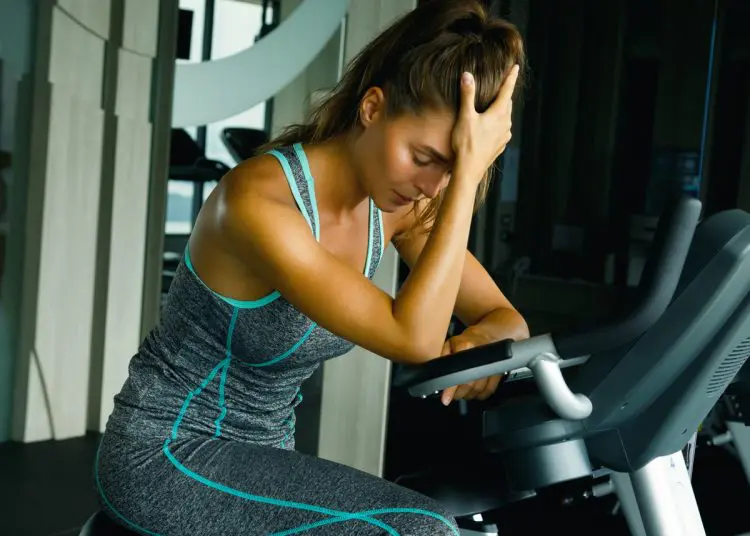Fitness experts LOVE to argue! Ask a group of ten trainers how best to achieve your workout goals, and you’ll probably get ten different answers.
Some will tell you high-intensity interval training (HIIT) is the best way to burn fat and get fit, while others are convinced that long, slow cardio is the way to go. Many coaches believe free weight exercises are the most effective muscle builders, but others say that calisthenics is the best choice.
Many of these coaches go so far as to cast shade on the training tools or approaches they don’t like or disagree with.
Ultimately, such arguments are pointless because training methods are simply tools, and most people will get better results if they use all the tools that are available. After all, no carpenter would ever limit themselves to just using a hammer. Instead, they’ll use a range of devices and gadgets to ensure that they can do the best job possible.
Savvy exercisers should use a similarly all-inclusive approach. Sometimes, HIIT is best, but other times, slower-paced cardio may be preferable. Barbells might be best for squats, but dumbbells may be better for bench presses. There is no need to use just one type of training equipment or workout. It’s a case of matching your workout to your goals and circumstances.
The Benefits of Regular Exercise

The one thing that all fitness experts do agree on is that working out regularly and consistently is good for your health. Lifting weights, running, doing yoga, swimming, playing sports, etc., can all have a very positive effect on your mental and physical wellbeing, including (1):
Level Up Your Fitness: Join our 💪 strong community in Fitness Volt Newsletter. Get daily inspiration, expert-backed workouts, nutrition tips, the latest in strength sports, and the support you need to reach your goals. Subscribe for free!
- Increased muscle strength
- Better bone density
- A stronger, healthier heart and circulator system
- Weight management
- Lower blood pressure
- Improved immunity
- Healthier lungs
- Less back pain
- Better posture
- More mobile, stable joints
- Reduced risk of many diseases
- Improved mental health
The caveat is that you need to work out regularly, long, and intensely enough to trigger the physiological adaptations that produce these benefits. According to most fitness authorities, that’s 150 minutes per week of moderate-intensity exercise, or 75 minutes of high-intensity exercise (2).
However, if you are a serious exerciser, you may want (or need) to do considerably more exercise than these recommended amounts. After all, the average bodybuilder probably works out for 90 minutes per workout, 4-5 days per week, far exceeding the CDC’s recommendations of 75 minutes of high-intensity training per week. The same is true for many group exercise participants, who probably do 3-5 60-minute classes per week.
This raises the question; how much exercise is too much?
How Much Exercise is Too Much?
Doing too much exercise, which is often called overtraining, could be bad for your health. But what actually constitutes too much? Unfortunately, this is not an easy question to answer because what is too much for one person may be very tolerable for another.
When you work out, you expose your body (muscles, joints, nervous system, etc.) to stress. That stress causes damage and breaks your body down a little. In response, and with adequate rest and food, your body adapts and “grows back” a little fitter and stronger so that your next workout is not so stressful.
The process of breaking down is called catabolism, and the process of rebuilding is called anabolism.
If your workouts exceed your ability to recover, you’re doing too much exercise. This means you should either a) reduce the frequency, duration, or intensity of your workouts to allow your body to catch up, or b) find ways to recover better.
Ways to enhance recovery include:
- Increasing your calorie intake (Find your daily calorie intake)
- Consuming more protein (Find your daily protein intake)
- Eating more healthily
- Getting more sleep
- Cutting back on additional physical activity
- Using enhanced recovery methods, such as massage and ice baths
- Include periodic deloads in your training schedule
Related: 8 Ways to Speed Up Recovery After Training
Providing your workouts do not outpace your ability to recover, you can do A LOT of training without overdoing it. Professional athletes often train four or more hours per day. However, as well as their workouts, they also rest and recover like pros too.
Some may also use performance-enhancing drugs (PEDs) such as anabolic steroids. Contrary to popular belief, these substances don’t make workouts easier or more productive. Instead, they enhance recovery so that the user can train harder or longer than usual and then recover better, usually by increasing protein synthesis.
That’s not to suggest that using PEDs is a good idea or recommended in any way. However, PEDs mean that users can recover from workouts that would be far too long or intense for natural exercisers. That’s why you should always be wary of following a workout written by a PED user; you won’t have the same enhanced recovery ability, and following the same routine could soon lead to overtraining.
All of this means that what may be too much exercise for one person is exactly the right amount for someone else. Like so many aspects of training, there is no one-size-fits-all recommendation for the amount of exercise you should do.
It’s up to you to match your workouts to your ability to recover. The good news is that there are plenty of things you can monitor that will tell you when you’re overdoing it.
Signs and Symptoms That You’re Doing Too Much Exercise
If you are making good progress and feeling fine, you are probably recovering well from your workouts. However, if you are experiencing more than a couple of the signs and symptoms outlined below, you could be in the throes of overtraining.
1. Your progress has stalled– while short plateaus are normal, if you aren’t generally getting stronger, fitter, losing weight, or otherwise making noticeable progress toward your training goal, you may be doing more exercise than your body can recover from.
2. You’re regressing– too much exercise could lead from no progress to regression. If you are losing strength, getting less fit, or otherwise backsliding, even though you are working out regularly, your workouts are outpacing your body’s ability to repair itself.
3. You’re gaining fat– fat gain despite training is usually the result of excess cortisol, which is your primary stress hormone. Cortisol levels should fall between workouts, but if you are training too much, they’ll remain constantly elevated, leading to issues with your metabolism and unexpected weight gain.
4. You are constantly sore and achy– post-exercise muscle soreness is part and parcel of working out. It usually comes on 24-48 hours after a workout and dissipates gradually over a similar time. However, if you feel sore all the time, this suggests that you aren’t recovering properly between workouts. Constant joint pain is another indicator that you may be overdoing it.
5. You’ve got nagging injuries– with adequate rest, minor injuries normally clear up by themselves. However, if you got an injury that just won’t heal, it may be because you are training too much. After all, the mechanisms responsible for recovery after exercise are the same as those involved in injury repair. A reduction in training could give your body the energy and resources necessary to fix whatever is ailing you.
6. You’re moody or stressed– short temper? No tolerance for BS? Feeling anxious or unusually emotional? Mood swings? You could be overtrained. A healthy body normally means a healthy mind, so if you are experiencing mental or emotional changes, it could be because your workouts have exceeded your ability to recover.
Level Up Your Fitness: Join our 💪 strong community in Fitness Volt Newsletter. Get daily inspiration, expert-backed workouts, nutrition tips, the latest in strength sports, and the support you need to reach your goals. Subscribe for free!
7. You can’t sleep– ironically, the more overtrained you are, the less likely you are to be able to get the sleep you need to recover from your workouts. That’s because exercise is a form of stress, and too much stress can mess with your circadian rhythm, which is how your body regulates your waking/sleeping cycles. Less sleep means you are even less likely to recover from your workouts.
8. Your resting heart rate is higher than normal– if your resting heart rate (your heart rate on waking or while sitting quietly) is ten beats per minute or higher than normal, you could be overtrained. A higher than average resting heart rate suggests your body is working harder than usual. You may also feel that your heartbeat is more noticeable and that you can feel it pounding in your chest.
9. You keep getting ill– exercise should enhance immunity, but overtraining can cause your immune system to take a dive, leaving you open to bugs and germs. If you keep getting ill, it could be that your immune system is depressed, and you are unable to fight off illness as effectively as usual.
10. Changes in your appetite– overtraining can increase or suppress your appetite. If you notice that you are either much hungrier than usual or not hungry at all, overtraining could be the cause.
11. Loss of motivation– exercise should be an enjoyable experience and one that you look forward to. It’s normal to have the occasional lapse of motivation, but if you have really gone off exercise, it could be a sign that you are not fully recovered between workouts. If you dread training, overtraining is a possible culprit.
12. Stomach upsets– too much exercise can cause a range of stomach issues, including bloating, constipation, and diarrhea. Occasional stomach upsets are entirely normal, but chronic gastric problems are often the result of prolonged stress.
13. Irregular or absent menstrual periods– overtraining can interfere with your normal menstrual cycle. If you are missing periods, or they are irregular, and you’re not pregnant or menopausal, it could be due to too much exercise.
14. You’re tired all the time– needless to say, if you aren’t recovering from your workouts, you’ll probably feel tired and listless away from the gym too. If even non-strenuous activities feel like hard work, you may be over trained.
15. Loss of sex drive– overtraining can mess with your hormone levels. If your sex drive is much lower than usual, too much exercise could be the cause.
Recovering from Overtraining
Some people make the mistake of training harder or longer when they first notice that their workouts aren’t as productive as usual. After all, if you are getting weaker and not stronger, or gaining fat instead of losing it, more exercise is the obvious solution, right?
Unfortunately, this is the last thing you should do and will obviously make matters much worse.
If you believe that you are overtrained, it’s important to take action sooner rather than later. If you keep training beyond your body’s ability to recover, you’ll only dig yourself into a deeper rut, which will take longer to climb out of.
That’s why deloads are so helpful; they’re mini-breaks from training designed to prevent overtraining in the first place.
Read more about when and how to deload here
Recovering after a period of overtraining can take weeks, months, or even years. The length of your recovery depends on how overtrained you are and how soon you take the necessary action.
Strategies for overcoming overtraining include:
1. Take a break from training– stop flogging that dead horse! If you are unable to recover from your workouts, it’s time to take a break. Stay active by walking and other low-intensity activities but give your body and brain a rest by taking part in no formal training until you start to feel recovered.
2. Eat nutritiously– your body needs an abundance of vitamins, minerals, antioxidants, and protein to recover from exercise and overtraining. Avoid the temptation to find solace in junk food. Instead, eat as clean as you can to minimize fat gain and provide your body with the nutrients it needs for energy and repair.

3. Re-evaluate your workouts– if your last training schedule led to overtraining, that suggests it wasn’t the right workout for you. Look for or design a more conservative workout plan so that you won’t become overtrained again. Make sure you include adequate rest days.
4. Ease yourself back into training gradually– don’t be tempted to do too much exercise too soon. Diving straight back into an intense workout schedule after overtraining could put you right back where you started. Start off with short, easy, and infrequent workouts and increase gradually over several weeks. Back off if you notice any of the symptoms of overtraining returning.
5. Assess your training goals– while having training goals can be very motivating, if your goals are too lofty, trying to reach them could be why you ended up training too hard, often, or long. For example, if you are a novice runner, training for a marathon may simply be too much for you right now. Like fitness, your ability to recover between workouts increases with time. Consider lowering your sights and working toward a more attainable goal.
6. Ask for help– if you feel guilty when you miss a workout, can’t help but train excessively, feel like you have to work out even when you are ill or injured, or exhibit any other signs of exercise addiction, you should seek professional help. If you don’t, the chances are high that you’ll experience overtraining again and again. Chronic overtraining can cause irreparable damage to your health.
Wrapping Up
Think of your workouts like digging a hole. Training takes soil out of the hole, and rest, food, etc., put soil back in. Ideally, you should refill the hole before you exercise again and, better still, build yourself a small hill, so you’ve got more soil than when you started. If you don’t, that hole will just keep getting deeper.
While it’s impossible to say precisely how much exercise is too much, it’s clear that you CAN have too much of a good thing. If your workouts take more out of your body than rest, recovery, and your diet can put back in, you are probably doing too much. And, if you feel that you need to do hours of exercise to lose or control your weight, you may be overeating. Eat less, and you won’t have to be a slave to your workouts.
Because of this, what you do outside of the gym is arguably more important than what you do in it. Sleep, your diet, and other essential recovery strategies will determine how much exercise you can tolerate.
If you recover hard, you’ll be able to train hard, too.
References:
1. Centers for Disease Control: Benefits of Physical Activity https://www.cdc.gov/physicalactivity/basics/pa-health/
2. Centers for Disease Control: How Much Physical Activity Do Adults Need? https://www.cdc.gov/physicalactivity/basics/adults/
















